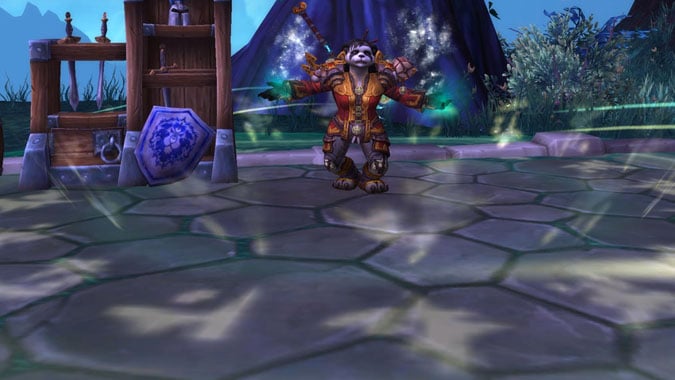Zen Meditation: Theorying your monkcraft

Thanks to Ask Mr. Robot, there’s been a fair amount of discussion about theorycrafting. Many players are intimidated by a perceived high barrier of entry, afraid it’s too difficult to get into theorycrafting.
Honestly, theorycrafting is not for everyone. The job ends up being pretty thankless. You’ll have more disagreements than agreements, and you’ll find yourself wrong more often than not. However, at least for Windwalker and to some extent Mistweaver, it’s probably more intimidating that it is actually difficult.
There’s no set time to theorycraft. I’ve been referred to as a so-called Windwalker theorycrafter (though I can’t say I’ve ever actually referred to myself by this title). Sometimes, people might visit my stream, and ask me to begin theorycrafting as if this were something that people sit and do mechanically, as if to simply say today I’m theorycrafting and that be the end of it.
It’s not quite like that. Rather, you begin with a question. This can range from a more simple question, such as which of these two same item-level weapons do more damage? to what’s the most optimal opener with this set of talents? In some cases, you can simply plug in a few tools and find your answer that way. In other cases, you could plug in more tools, but it might require more advanced skills and knowledge. First, let’s get an idea of how theorycrafting for each spec works.

Brewcrafting
There’ve been many, many proposed methods for how to theorycraft a proper tank. The issue? Context. Mitigation matters… to a point. After a while, its importance drops off and your damage throughput becomes more important. But where does this specific mark actually happen?
Years ago, Theck proposed TMI, the Theck-Meloree Index. This standard measured the smoothness of a tank’s damage intake. SimulationCraft will still provide a TMI rating for tanks with specific setups, but even then you may find people cautioning you that this may not be completely “correct.”
So what’s a Brewcrafter to do? Figuring out how to do more damage doesn’t always work out, either — after all, the current meta generally indicates this as a tradeoff for mitigation, and you’re a tank, so don’t you want to favor mitigation?
Not always. Rather, your job as a tank ends up — as mentioned early in this section — finding the sweet spot of mitigation and damage. When I acted as a main tank, I generally took progression a bit easier. The first few pulls, I might use a bit more Mastery gear to make damage intake smoother, then slowly trade that out for Crit gear (this being prior to the introduction of Multistrike, may it rest in pieces). This is how you find that sweet spot. You figure out the strength of your healers, and when you can begin to lean more and more into a damage build. From there, your questions focus more around how much mitigation is enough, and how you can optimize around that for higher damage.

Craftweaving
The good news here: Mistweaver theorycrafting doesn’t end up being the convoluted science that Brewmaster can be. Your spells generally serve one or two functions; you simply need to figure out what situations they work best in. Much of this comes from a general understanding of your class, and of how encounter mechanics actually work. For example, you might want to blanket the raid in Renewing Mist to keep everyone’s health pretty even. Or, maybe the tank’s going to take a huge spike. Rather than being reactive to that spike, be proactive — throw your Enveloping Mist on him and get ready to Surge him to full.
Additionally, you’ll still want to know how your secondary stats work. Your questions might surround asking how Haste affects your spells, or which spells your Mastery will affect in Legion. If you aren’t sure, then that’s where you begin your theorycrafting. You test it. Combat logs and WarcraftLogs are your friends. If you need help, the community is always available to back you up, whether that be in Discord or on forums.
Otherwise, your questions end up being aimed at two areas: your healing throughput, how to be more mana efficient, and — surprisingly — damage throughput. Spreadsheets do exist for seeing healing throughput and how it grows with different amounts of each stat, or how to optimize your spells for mana efficiency. However, again, context matters. Your healing throughput will still rely on the raid taking damage, and so in some encounters you may simply have higher throughput than others. Spreadsheets will not tell you how much throughput to expect, but it can help you feel out which spells might do more healing in specific situations.

Windcraft
Even for Windwalker, as a DPS, your primary tool will not be SimulationCraft. It also won’t be spreadsheets.
Your character, actually, functions as your primary tool.
I personally tell people to sim themselves all the time, and I encourage people to familiarize themselves with the tool. Let’s take a look at a little bit of Monk history to illustrate why. When Blizzard changed Way of the Monk to shift balance between dual wielding and two-handers, we didn’t immediately go to SimulationCraft. Sure, it helped for the final results, but the first thing we did happened to be copying monks to PTR or beta (depending on the current cycle) and equipping white weapons of each type.
The first test doesn’t require terribly much user input. I simply copy my character to PTR or Beta, remove their gear, and write down their base stats at the time of testing (if you’re a Night Elf, this is especially important. Depending on the time of day, you may have more Crit or you may have more Haste). Following that, park in front of a training dummy with nothing but white weapons equipped, start up Warcraft Logs, and then leave your character auto-attacking for half an hour or longer. This allows you to evaluate the damage you’re receiving from dual wield vs. the two-hander: are you receiving more crits from one? What about misses? Are certain class-specific proc buffs seeing more uptime with one than the other? Obviously, with Artifacts, you won’t be comparing against staves or swords anymore, but there are still plenty of things to be tested within the game.
This is the point, then, where you might bring your character into SimulationCraft or a spreadsheet in order to gather important data, such as spell breakdowns and to see more specific details of what may seem different between two weapon setups. However, you’ve already accomplished a pretty important step. You’ve now effectively used one of your tools and evaluated the data from it. Congratulations — and welcome to theorycrafting.
If you want to take it a step further, a good Monk friend of mine, Total, created this guide for how to use SimulationCraft. There is also Ask Mr Robot’s simulator.

Find your own answers
While Peak of Serenity exists in order to help you with most questions and answers, the best way to really get into theorycrafting is to simply try to find your own answers. We’re always happy to offer guidance and help in how to do that, and to give you the base, starting information. However, most questions can be answered with simply learning how to use SimulationCraft and logs, or with hitting a target dummy for an hour. Most of us got into this with a question that we couldn’t answer, or out of pure curiosity of how certain mechanics work.
And further — most of the Monk community is pretty welcoming. Once you get started with finding your answers, you’ll find there’s not terribly much mystique to theorycrafting. Most of it involves a bit of trial and error. The hardest part? Finding the answers to the right questions, without enforcing our own bias into them.
Please consider supporting our Patreon!
Join the Discussion
Blizzard Watch is a safe space for all readers. By leaving comments on this site you agree to follow our commenting and community guidelines.
 @CalliMonk
@CalliMonk




